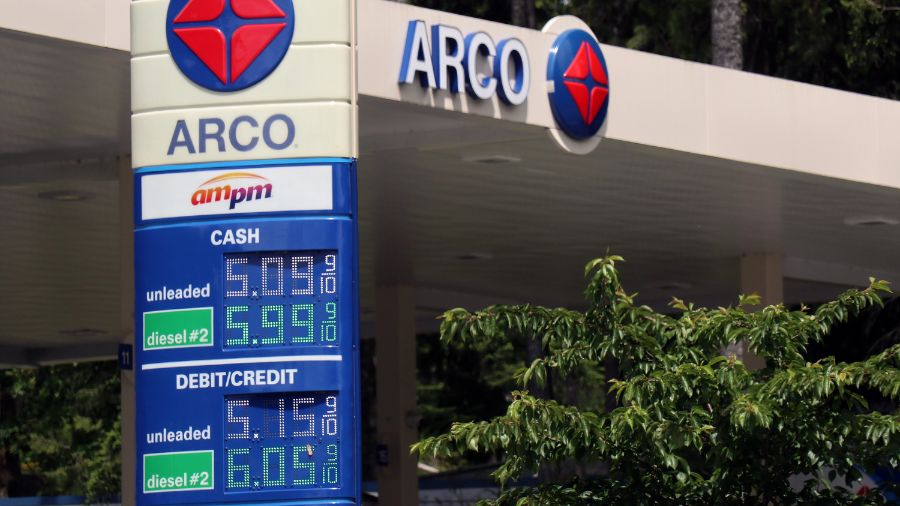Washington most expensive state to buy gas for first time in history
For the first time ever, Washington is the most expensive state in the country to buy gas. According to AAA, the price for a gallon of regular unleaded gas is averaging $4.91 statewide. Mid-grade gas is around $5.09/gallon, and premium averages $5.29.
As of Tuesday, Washington ranks No. 1 in all three categories, and additionally boasts the third-highest price in the U.S. for diesel, at $4.94 per gallon.
NEW: As of today. WA state now has the highest regular, mid-grade, AND premium gas. Still #3 for diesel. State avg. is up to $4.91. For unleaded. Seattle-Bellevue-Everett metro avg. pushed past $5/gal for regular this morning. — Kate Stone (@Kattressa) June 20, 2023
In King County, the average price for regular gas has surpassed $5 per gallon while Pierce and Snohomish County drivers will pay approximately $4.90 a gallon. In the Seattle area, prices for regular grade have risen nearly 75 cents since January.
Some drivers claimed they can’t keep up with the surge, but have little choice.
“Unfortunately, I need my car for work, so we’ll have to budget in other ways,” Katie, a Seattle resident, told KIRO Newsradio.
The data showed an increase of more than 30 cents statewide in the past month for regular gasoline. Of other neighboring states, only Oregon saw a bigger increase in that time period, with a 40-cent jump. However, Oregon’s current average of $4.56 per gallon for unleaded gasoline remains 35 cents below Washington.
A comparison (increase in one month for regular grade, per AAA): WA: $0.29/gallon ($4.89 state avg.)
OR: $0.37/gallon ($4.53 state avg.)
ID: $0.22/gallon ($3.97 state avg.)
CA: $0.07/gallon ($4.87 state avg.) — Kate Stone (@Kattressa) June 20, 2023
What is causing the spike is a matter of intense debate. Some point to the state’s new “cap and invest” emissions program, which was implemented in January. The program sets a limit — or cap — on overall carbon emissions in the state and requires businesses (including fuel suppliers) to obtain allowances equal to their covered greenhouse gas emissions. These allowances can be obtained through quarterly auctions hosted by the Washington State Department of Ecology. They can also be bought and sold on a secondary market, similar to a stock or bond.
WA’s second carbon auction nets $500M, gas prices could jump
According to Todd Myers with the Washington Policy Center, this program means drivers will pay more at the pump.
“The way fuel suppliers in California and Washington have done it is that they have simply, rather than try to speculate what the future prices will be, incorporated the cost of the allowances immediately into gas prices,” Myers told KIRO Newsradio. “So, what you see is, the gas price almost immediately reflects what those prices are.”
But Luke Martland, Climate Commitment Act Implementation Manager with the state Department of Ecology, claimed it’s not that simple.
“What determines what we pay at the pump in Washington is supply and demand: The war in Ukraine, what Saudi Arabia may do, how much profit oil companies take from the sales. It’s a whole bunch of factors — and cap and invest might be one of those factors. But to say there’s a direct connection is simply not accurate.”
@GasBuddy chart showing the past 6 months of #gasprices, U.S. average compared to WA and OR. The cap-and-trade emissions program took effect in January, but the Department of Ecology/Gov. Inslee’s office say many factors affect prices. OR does not have cap & trade program. pic.twitter.com/erKikCnx0T — Kate Stone (@Kattressa) June 20, 2023
Patrick DeHaan, Head of Petroleum Analysis for GasBuddy, said the link between the cap-and-trade program and gas price increases is clear.
“Washington state has seen its prices going up because of the new system,” DeHaan said. “And now Oregon’s gas prices are on average over 45 cents a gallon lower. So, whereas Washington state and Oregon used to have very similar prices within just a few cents, with the advent of the carbon tax ever since the start of the year, we’ve seen a growing disconnect between Oregon and Washington.”
Last July, a letter from the Department of Ecology to state lawmakers regarding the cap-and-invest program said in part, “if the price of gas is around $5 per gallon as it is today, this would translate into an additional 5-cents-per-gallon in 2023.”
In January, the statewide average per gallon was $3.92 across all grades, according to the U.S. Energy Information Administration. As of May, it has risen to $4.59, an increase of 67 cents.
Source: MyNorthwest


